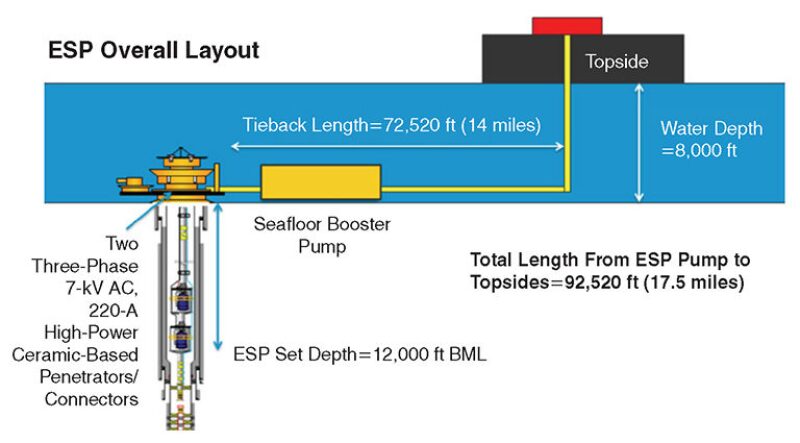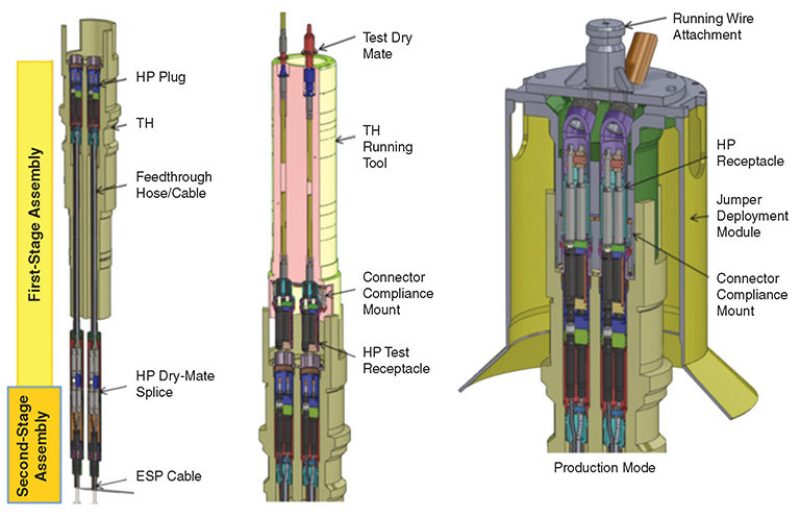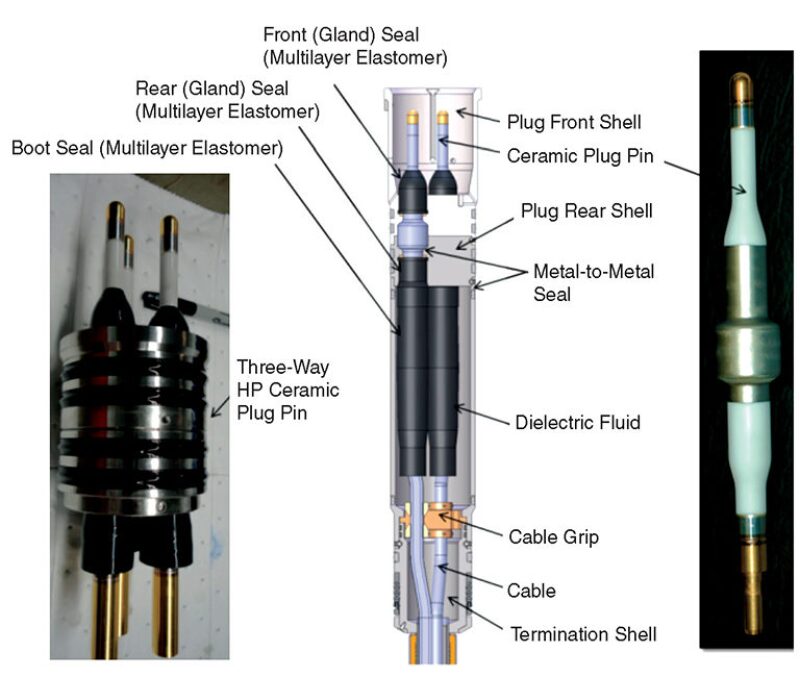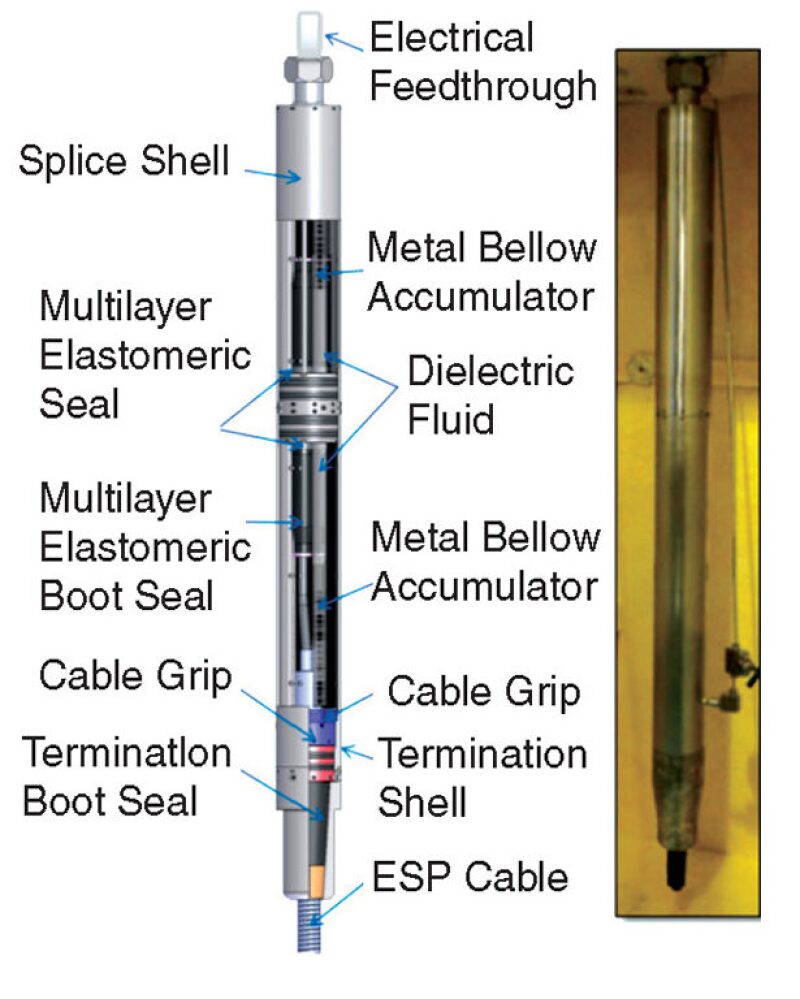Reliability of subsea equipment is an indispensable requirement in deepwater applications. Tubing-hanger (TH) -connector systems can be a critical failure mode for electrical submersible pumps (ESPs) in high-pressure/high-temperature (HP/HT) environments. Through use of reliability tools such as fault-tree analysis (FTA), failure-mode effect and criticality analysis (FMECA), and systems reliability block diagrams (RBD), it was established that improving the reliability of the TH-connector system has a direct effect on the unintervened life of the ESP electrical system.
Project Basis of Design
A joint development project between the operator and the connector-system supplier focused on the design, installation, and intervention of downhole ESPs in deepwater subsea wells in the Lower Wilcox developments in the Gulf of Mexico. The system design encompasses the ESP completion, subsea wellhead, tree, TH, and power and control system. The system design criteria are for 8,000‑ft water depth and a 14-mile tieback (Fig. 1).

Connector-System Reliability Overview
At the start of the project, the operator, the connector-system supplier, and other equipment vendors met and agreed to align their reliability plans. Common reliability tools, including FTA, FMECA, and systems RBD, help all collaborators to have a better understanding of the relationship and sensitivity between subsystem reliability and the unintervened life of the ESP electrical system.
FMECA. The FMECA process is typically performed by the present multiple teams to capture different backgrounds and benefits for a wider range of feedback. In this process, each component and subsystem is considered and its corresponding functions are identified. The purpose is to consider the conceivable failure modes associated with each component and function on the basis of prior art, knowledge, and industry experience and then develop plans to mitigate such failure modes in a hierarchy that is based on the criticality.
To establish the criticality associated with each failure mode, the severity, probability of the failure (P), and current controls used to detect failures before occurrence (D) are determined and ranked. The rankings are set on a scale of 1 to 10 points for the severity (S), with 1 being no effect and 10 being catastrophic failure; for occurrence (O), with 1 being very unlikely to occur and 10 being extremely likely; and for detectability (D), with 1 being immediate detection and 10 being almost impossible to detect for each failure mode. These three numbers are multiplied to determine the risk priority number (RPN) of each failure mode: RPN=S×O×D.
The RPN is used to determine a risk classification of high, medium, or low for each failure mode on the basis of ranges set at the beginning of the FMECA exercise. All high-risk items are required to have a mitigating action in place, and that is typically followed by addressing all medium-risk items also. The ultimate goal is to bring every failure mode to a low-risk level and to have mitigated or considered all low-risk items at some point during the development process.
Accelerate Life Testing (ALT). The concept of ALT is testing under stress levels in excess of those of expected operating conditions. The experimental data results are used to project performance under actual-use conditions. Several stressing methods can be used. The choice of stressors typically depends on expected exposures during operation. Stressors may include temperature, voltage application, load, or chemical exposure. Test setups are designed on the basis of failure modes of interest such as contamination, electromigration, corrosion, and creep.
The three main components of ALT are test planning, acceleration models, and parameter estimation. Test planning includes the physics-of-failure study to understand the failure mechanism and the input variables. Other aspects of test planning include the number of test units, test time, and test setup. An acceleration model describes the relationship between the acceleration variable (e.g., temperature) and the life of the units under test.
FTA. A fault-tree model, a tool commonly used to establish the reliability on the basis of statistical knowledge of various failure modes and their frequency of occurrence, is implemented during the system-reliability analysis. The systems fault tree encompasses all vendor subsystems that are broken down to the subassembly and component level. This helps the teams identify the effect of each component on the reliability of the integral system and the degree of sensitivity.
HP/HT-Connector-System Overview
High-Power-Connector-System Concept-Design Overview. The design of an ESP high-power (medium-voltage) connection system comprises a wet-mate penetrator connector pair, TH feedthrough, and dry-mate splice/ESP-cable termination (Fig. 2). The design is based on existing high-power connector technology, with each phase of the electrical system isolated and electrical stress relieved adequately for long-term reliability. The design uses various insulation materials including ceramic, polyether ether ketone, and multilayer elastomeric seals to achieve phase isolation in addition to mechanical sealing. The penetrator is composed of a ceramic-insulation-based wet-mate plug pin, which is intended as a secondary pressure barrier from annulus to environment. The wet-mate connection is achieved by means of an oil-filled and pressure-balanced receptacle module.

The dry-mate splice is divided into two canisters, or a two-stage assembly: The upper canister (first stage) is assembled and oil filled in house after mounting the wet-mate plug pin and feedthrough onto the TH. The lower canister (second stage) is installed and oil filled in field, terminating to the predeployed ESP cable.
The upper and lower dry-mate splice canisters are oil filled with dielectric fluid and designed to be pressure balanced to annulus pressure at all times.
HP/HT Wet-Mate Ceramic Penetrator. The TH HP/HT penetrator assembly consists of a three-way high-power wet-mate ceramic-based plug pin (Fig. 3). The design is based on the use of metalized-ceramic insulation that is electron beam welded to a copper pin. The ceramic insulation has been selected on the basis of its ability to support high pressures at high temperature with minimal creep or degradation over time.

Dry-Mate Splice for ESP-Cable Termination. The dry-mate splice is in the annulus and is divided into two isolated compartments (Fig. 2 and Fig. 4). The first compartment (upper canister) is part of the first-stage TH assembly and oil-filling process. The second compartment (lower canister) is part of the second stage, is installed and oil filled in field, and terminates at the ESP. Both compartments are pressure balanced to annulus pressure by use of metallic bellows accumulators. Throughout the connector system, the shielded conductor boot seals are considered the primary insulation and are designed to operate reliably in a totally flooded (annulus-fluid-ingress) condition. The dielectric fluid surrounding the conductor boot seals is considered secondary electrical insulation. The material selection is based on a long-term material-compatibility program that was tested specifically in the annulus environment.

ESP High-Power Receptacle Module. The three-way receptacle subassembly consists of three individual-phase isolated receptacle stem modules. The receptacle stem module houses the socket contact stem, which consists of gold-plated contact seats and silver-plated contact bands mounted within a carrier on the end of a conductive tube that houses a spring-biased retracting insulating stopper. The stopper seals a dielectric-oil-filled, pressure-balanced chamber that surrounds the socket contact. Each contact has its own oil-filled chamber, and, in turn, they are housed inside a common secondary oil-filled chamber, thus giving two independent barriers between the circuit and the environment.
During the mating action of the two halves of the wet-mate connector, the plug/pin contact enters the socket chamber by displacing the stopper, and, at the same time, its surface is wiped clean of any seawater, surrounding fluid, or contamination by a series of wiping seals at the front of the chamber. The electrical connection is established within the benign-fluid environment. During disconnection, the plug retracts from the receptacle chamber and the spring-biased insulating stopper returns and fills the vacated space and seals off the chamber to prevent any oil leakage or external-fluid ingress.
Prototype Testing
Because the technology is relatively new, comprehensive prototype-validation testing was necessary for benchtop-configured components and subassemblies in a relevant environment. More than 50 prototype tests were performed to mitigate all high technical risks and most medium risks before starting the qualification program.
The extensive prototype-validation-program tests provided the flexibility to perform adjustments for design optimization and provided more confidence (reduced risk) during the qualification program and system-integration tests at the field. Please see the complete paper for examples of the prototype-validation tests that were performed.
Qualification Program
The qualification program was conducted over 18 months. During the first 4–5 months, the qualification test procedures were prepared and approved. In the meantime, three preproduction connector sets were built through a complete production cycle. During the next 12–16 months, the short-term tests and the long-term tests were performed simultaneously.
System-Integration Tests
The project planned for a system-integration test of the complete high-power connector system and subsea-equipment-supplier components. The scope of the test is to use full-scale production parts of each component. The testing goals were
- Use full-scale production parts.
- Measure continuity of the connection of the high-power wet-mate system.
- Validate assembly procedures.
- Verify debris tolerance of high-power connector system.
Conclusion
Throughout the duration of the joint development technology project between the operator and the connector-system supplier, the focus has been on reliability of the high-power connector system. The key factors for a well-established reliability system for this connection-system project are the following:
- Reliability consideration from the beginning of the project (concept design), by use of the FMECA process and other tools
- Comprehensive materials-compatibility and -aging program
- Extensive prototyping effort and component-validation test, with more than 50 prototype tests performed to mitigate all high risks and most medium risks before starting the qualification program
- Integration fit testing using operator equipment or prototype equipment
- Full qualification testing (short term and long term) that encompasses different industry standards along with nontraditional qualification tests that are based on the application
- Early system-integration tests and system deployment to obtain field experience
- Coordinating high-power-connection-system reliability with other reliability systems and teams by use of reliability tools such as fault-tree diagrams.
This article, written by Special Publications Editor Adam Wilson, contains highlights of paper OTC 24138, “Reliable High-Power ESP Tubing-Hanger Connector Systems for Deepwater Downhole Applications,” by Sami Spahi, Teledyne Oil and Gas, and Pamela Parsley, Chevron Energy Technology Company, prepared for the 2013 Offshore Technology Conference, Houston, 6–9 May. The paper has not been peer reviewed. Copyright 2013 Offshore Technology Conference. Reproduced by permission.
